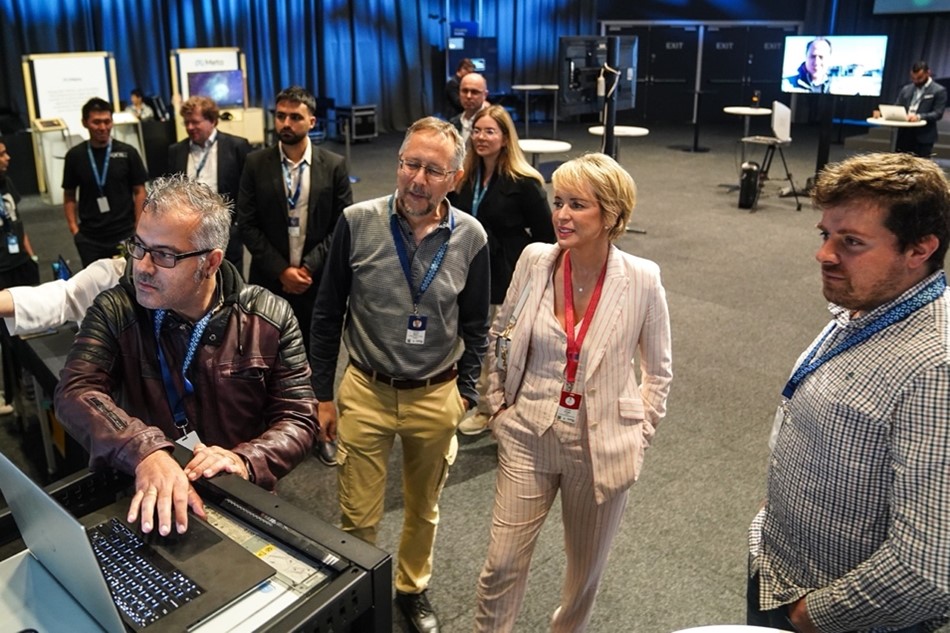QSNP members exhibit a mini EuroQCI demonstration during the Presidency event of Sweden
12 September 2023
Quantum experts from UPM, LuxQuanta and QTI present a demonstration of an ultra-secure video-call introducing the future of European quantum secure networks.
On June 15th, Sweden took over the presidency of the European Council, and as part of its agenda, it co-organized the “Digital Assembly” event in Stockholm, together with the European Commission. With the aim of promoting an open, secure and digital Europe, the event sought to showcase different technological advances to underline a “Europe to be at the forefront of technology and develop a competitive digital single market based on a strong focus on cyber security during the Digital Decade”.
UPM and Partners Demonstrate Live Quantum-Secure Video Conferencing
The Polytechnic University of Madrid (UPM), partner of QSNP, managed the network, providing the control a key management infrastructure during the entire event, and in collaboration with LuxQuanta – also partner of QSNP- and the Italian company QTI, they carried out a live demonstration of a quantum secure communication. The personnel executed the live video conference call to recreate a mini version of the European Quantum Communication Infrastructure (EuroQCI) and showcase the level of maturity of quantum technologies for telecommunications. The ultra-secure video-call used the Quantum Key Distribution (QKD) protocol to enable a secure call between the parties and allow them to converse safely. This QKD technique encrypts the keys shared between the two parties using the principles of quantum mechanics, making interception impossible without detection
For this demonstration to take place, the team used a hybrid classical and quantum network using remote connections to the quantum devices in Spain and Italy.

As explained in the image, the quantum layer used LuxQuanta’s link in Barcelona and QTI’s link in Florencia to transport the keys using the QKD protocol and establish a secure channel for the nodes. The personnel introduced the keys into two crypto devices placed at the UPM in Madrid. With these quantum keys, the crypto devices generated an encrypted channel between two network endpoints – two in Stockholm and one in Stockholm and the other in Madrid. The first encrypted channel facilitated the on-stage demonstration, where Telsy held a live videoconference. The second encrypted channel served the rest of the assembly, demonstrating a continuous and stable connection in communication.
European Quantum Network Successfully Demonstrated
UPM developed and supplied the SDN-based software for the network as well as the key management, including extracting the key from the quantum devices, created by LuxQuanta and QTI, and providing it to the encrypting devices. The key exchanges followed the standards developed by the European Telecommunications Standards Institute (ETSI). LuxQuanta, a member of the QSNP, provided one of the quantum links used to generate the keys. Other companies that participated include Rohde and Schwartz, providers of the crypto devices, and Ericsson and KTH, who gave local logistic support.
Vicente Martin, Principal Investigator of the Quantum Information and Computing Research group (GIICC), Director of the Center for Computing Simulation (UPM), and partner in the QSNP, states, “Projects within the Quantum Flagship, an ambitious program launched in 2018 to conduct research and development in the field of quantum technologies, developed all the technology used during this demonstration. The showcased technology includes not only the visible devices, but also those implemented within them, such as Quantum Random Number Generators (QRNGs), a critical component for the functionality of this technology. The Start-ups and Spin-offs that manufactured these generators also participate in this European Flagship”.
Quantum Communications Showcased at Conference
More than 800 visitors, including politicians/policy makers and industry representatives, were able to visit the booth, see the mini-EuroQCI demo and have an overview of what a quantum communication channel and video call actually looks like. Both devices from LuxQuanta and QTI were on display, as well as a complete quantum link from QTI. A quantum encrypted video-call between Stockholm and Madrid was showcased at a two-day conference to demonstrate the technology’s reliability. UPM’s Vicente Martin and LuxQuanta’s CTO Sebastián Etcheverry explained the technology to visitors during the live demonstration.


Vicente Martin (beside Carme Artigas), and Juan Pedro Brito, from UPM, together with Sebastian Etcheverry, fom LuxQuanta, show the QKD setup to Carme Artigas, the Spanish Secretary of State for Digitalisation and Artificial Intelligence.
“For this exhibition we were able to combine quantum technologies from five different companies, from three different European countries and display it in a fourth country. Putting everything together and making it work was a challenge. We considered it a huge success to show a large audience that quantum communications are real and can be deployed in complex environments” Martín concludes.
About QSNP
QSNP is a project of the Quantum Flagship initiative within the Quantum Communication research pillar. Its main objectives are to develop advanced technology for quantum secure communication networks against the ever-increasing power of computers and sophistication of algorithms (even for quantum computers), integrate quantum cryptography technology at component, system and network levels, also into classical communication, and establish this technology for quantum-safe critical governmental infrastructures, private telecommunication market sector and future quantum internet. It will work towards further developing and deploying post-quantum protocols based on QKD and integrating them into the classical network adding a new layer of ultra-secure communications. Ultimately, it seeks to create a sustainable European quantum communications technology ecosystem.
